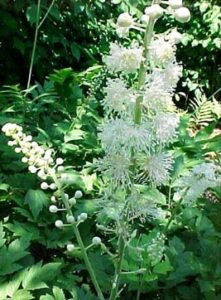Menopausal hormone therapy is prescribed to address menopause related symptoms, as well as to reduce risks of several chronic diseases and to treat select conditions. Despite its significant benefits, there are slight risks, and there are occasionally nuisance issues that require attention. One of these is breast tenderness. Breast tenderness can be caused by estrogen therapy. The usual adjustment is to lower the dose until the tenderness resolves. Breast tenderness from estrogen therapy can also over time increase breast density, which is a risk factor for breast cancer. In addition, estrogen plus a progestin longer than 4 years can very slightly increase the risk of breast cancer (about 1 more woman per 1,000 women per year). These issues are part of the conversation in discussing benefits vs. risks of menopausal hormone therapy.
 Black cohosh has a long list of published studies in the area of menopause symptoms. For many women, it will be adequate to address their menopause symptoms, in particular it is noted for hot flashes/night sweats and mild depression. Black cohosh tends to work best for mild to moderate menopause symptoms of this nature. It is not indicated for disease prevention or treatment.
Black cohosh has a long list of published studies in the area of menopause symptoms. For many women, it will be adequate to address their menopause symptoms, in particular it is noted for hot flashes/night sweats and mild depression. Black cohosh tends to work best for mild to moderate menopause symptoms of this nature. It is not indicated for disease prevention or treatment.
The current study was conducted in 96 women with no breast tenderness who were perimenopausal or postmenopausal. They were randomly assigned to 3 groups. Group A: Estradiol valerate 1 mg/daily plus medroxyprogesterone acetate 4 mg/for the last 12 days of the month. Group B: Estradiol valerate 1 mg/day and oral micronized progesterone 100 mg/for each of the last 12 days of the month. Group C: Black cohosh (Cimicifuga foetida) 100 mg/day; all for 12 months.
Breast tenderness was prevalent in 80% of Group A, 72% of Group B and 27% of Group C. The highest prevalence of breast tenderness in each group occurred at one month in group A (50%), at four months in group B (44%) and one, four and five months in group C. (18%) . While breast tenderness fluctuated in all groups, more than 50% of all women reported no breast tenderness. Group C had the most women with no breast tenderness.
Commentary: Breast tenderness is a fairly common reaction to estrogen or estrogen/progestogen therapy. It is usually an indicator that at least the estrogen dose should be lowered. While the prevalence of breast tenderness was similar in both hormone groups, it was a little higher in the group with the synthetic, medroxyprogesterone acetate than in those on the bio-identical oral micronized progesterone. This is interesting in that women on estrogen plus bio-identical oral micronized progesterone appear to have no increase in breast cancer after approximately four years, vs. the slight increase (1 in 1,000 per year), with the use of estrogen plus the synthetic progestin. I wouldn’t go so far as to say that this species of black cohosh reduced breast tenderness, because women did not have breast tenderness going into it. Rather, it did not cause breast tenderness in nearly as many women as the two hormone groups. On the other hand, black cohosh is likely not to help as many women with their menopause symptoms as does menopausal hormone therapy.
Reference. L. Gao, H. Zuo, T.Zheng, et al. Influence of hormone therapy of C. foetida extract on breast tenderness in postmenopausal women. Climacteric 2018;21(3):292-297.

